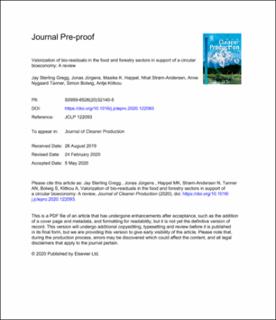| dc.identifier.citation | Gregg, J. S., Jürgens, J., Happel, M. K., Strøm-Andersen, N., Tanner, A. N., Bolwig, S. & Klitkou, A. (2020). Valorization of bio-residuals in the food and forestry sectors in support of a circular bioeconomy: A review. Journal of Cleaner Production, 267, 122093. | en_US |
| dc.description.abstract | This literature review focuses on valorization of bio-residuals from the brewery, dairy, slaughterhouse and forestry sectors. Bio-residuals are organic wastes, side streams, or residues that remain at the end of the processing of a biological raw material. These under-utilized resources have the potential to support circular bioeconomies, given they can be valorized through viable value chains. To better understand this potential and gain insights in the opportunities for these resources, we analyzed 57 publications that contained findings related to value chains for bio-residuals valorization. The value chains were partitioned into the categories of resource procurement, transport and handling, transformation and processing, valorization and market, and end use. Additionally, the contextual drivers were analyzed, including policy and governance, business strategies, economics, demand, innovation, research, and development, and actors and networks. After summarizing the state of the art in research for bio-residuals valorization, the value chains were categorized for each sector. The push-pull factors were then identified, and how these influence bio-residual value chains. These analyses reveal that the dairy industry has a well-developed value chain for bio-residuals, with a myriad products from whey being pulled by market demand. With the knowledge and capabilities of the dairies, this creates a modular value chain for these products. The slaughterhouse industry resembles the dairy industry, but has greater barriers for valorization of animal by-products and so less market pull, leading to more conglomeration of rendering operations. Valorization of slaughterhouse residuals indicates a captive value chain. Contrarily, valorization of brewers spent grains (BSG) has been slow to develop, due mainly to low supplier capability, and the BSG value chain is dominated by the use of unprocessed BSG as animal feed. The forestry industry has been slow to invest in technological and market capabilities for valorizing residuals, due to weak market pull, high capital needs, and risk-adverse strategies among the few incumbent firms. As a result, the value chain for forest residues is still mainly hierarchical and rather undeveloped; yet with the recent entry of many new firms competing for biomass for a variety of end products, a shift towards a relational value chain serving a greener and more complex industrial symbiosis production model could be developing. Synthesizing across the sectors, we conclude that the materiality of the residuals, regulations, transformation technology, firm capabilities, actors, and the market are all important factors shaping the value chains for bio-residual products, with each sector having unique challenges and opportunities related to their value chains. As such, more research is needed not only in transformation and processing of residuals, but also regarding more downstream parts of the value chain, such as end-product markets, as well as cross-cutting issues such as governance and regulation. This would better promote valorization pathways, creating a market pull rather than just a technology push for bio-residuals. | en_US |
